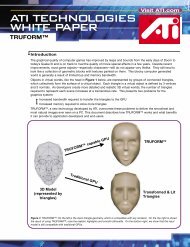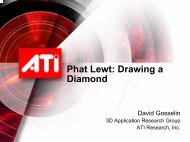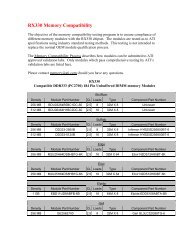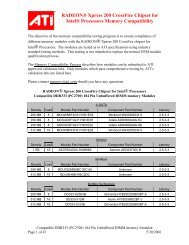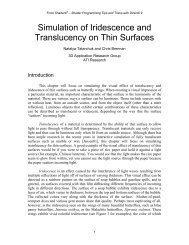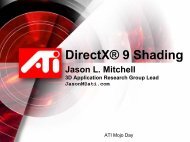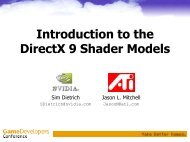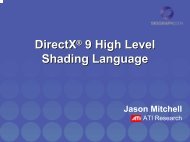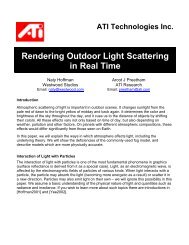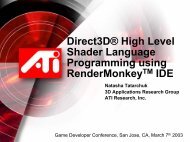ATI CrossFire Technology White Paper
ATI CrossFire Technology White Paper
ATI CrossFire Technology White Paper
Create successful ePaper yourself
Turn your PDF publications into a flip-book with our unique Google optimized e-Paper software.
Ultimate Compatibility<br />
Another limitation of previous multi-GPU techniques was that they did not always work well with all applications.<br />
This was due to a variety of reasons, including certain rendering techniques that were incompatible with the<br />
particular multi-GPU implementation, or heavy CPU dependence that created performance bottlenecks. In any<br />
case, these issues limited the value of adding a second GPU to a system.<br />
<strong>CrossFire</strong> is the first multi-GPU technology that can provide a benefit to any 3D application. This is made<br />
possible by its support for four different operating modes that maximize compatibility. The <strong>ATI</strong> Catalyst display<br />
driver will automatically select the best of the three performance modes when a 3D application is started,<br />
without requiring user intervention. Alternatively, the user can choose to improve image quality by selecting the<br />
new Super AA modes in the Catalyst Control Center.<br />
Ultimate Flexibility<br />
Earlier multi-GPU technologies were characterized by limited upgradeability. In general, they required two<br />
identical or near-identical graphics cards be installed in a system in order to allow them to work together.<br />
Furthermore, each of these cards typically had to be special models designed specifically for multi-GPU<br />
configurations. These special models could be more expensive or harder to find than standard models. Finally,<br />
this approach meant that every compatible GPU produced had to include logic to support Multi-GPU, thus<br />
increasing the cost of these products unnecessarily for those who had no need for such configurations.<br />
<strong>ATI</strong> <strong>CrossFire</strong> technology takes a novel approach to improving upgradeability. It is designed such that a<br />
Radeon <strong>CrossFire</strong> Edition board can be connected to any existing model, configuration, or brand of PCI Express<br />
graphics card that uses a Radeon X800 or Radeon X850 series GPU. This provides an easy upgrade path to<br />
existing owners of Radeon X800- or Radeon X850-based graphics cards. The dedicated <strong>CrossFire</strong><br />
Compositing Engine ensures that only users interested in multi-GPU configurations need to pay for the circuitry<br />
that makes it possible.<br />
In order to ensure the workload does not become too strongly mismatched between two cards with differing<br />
levels of performance, <strong>ATI</strong> <strong>CrossFire</strong> technology has the capability throttle the speeds of each GPU. This<br />
makes it possible to obtain better performance and image quality from almost any combination of compatible<br />
graphics boards.<br />
Summary<br />
<strong>ATI</strong> <strong>CrossFire</strong> technology offers the most advantageous means available of combining multiple high<br />
performance Graphics Processing Units in a single PC. Combining a range of different operating modes with<br />
intelligent software design and an innovative interconnect mechanism, <strong>CrossFire</strong> enables the highest possible<br />
level of performance and image quality in any 3D application.<br />
Copyright 2005, <strong>ATI</strong> Technologies Inc. <strong>ATI</strong>, Radeon, <strong>CrossFire</strong>, Catalyst, SmoothVision, MAXX, Rage Fury, and Rage 128 PRO are<br />
trademarks and/or registered trademarks of <strong>ATI</strong> Technologies Inc. simFUSION and RenderBeast are registered trademarks of Evans &<br />
Sutherland. All other company and/or product names are trademarks and/or registered trademarks of their respective owners.<br />
- 13 -



